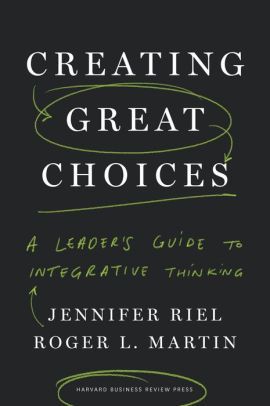Creating Great Choices – Jennifer Riel, Roger L. Martin

A fresh way to make decisions.
Integrative Thinking and Making Decisions
Traditional decision-making often follows these stages to get to a single choice or answer:
- We consider a number of choices, discussing the pros and cons of each choice or option.
- If available, we’ll present data for each option.
- We vote for our favoured choice (dot voting is a nice technique to use here).
- We end up with a single choice that we can or can’t all live with, and perhaps we made a compromise to get to the final decision.
Examine the Models
Here you actively encourage the tension that comes from looking at the two opposing models together, through a series of exploratory questions:
- Ask yourself how the models are similar and different.
- Consider what you most value from the models as they’re articulated.
- Question the models as you have articulated them and the benefits you’ve defined.
- Explore the assumptions that underlie each model, along with the cause and effects.
Exploring The Possibilities: Integrated Solution
There are three guiding questions that you can use to come up with a new, integrated solution:
- How might we create a new model using one building block from each opposing model?
- Under what conditions could a more intense version of one model actually generate one vital benefit of the other?
- How might the problem be broken apart in a new way?
Creating Great Choices
The four critical steps as part of the process for Integrative Thinking:
Articulate the models – Understand the problem and opposing models more deeply.
Examine the models – Define the points of tension, assumptions, and cause-and-effect forces.
Explore the possibilities – Play with the pathways to integration.
Assess the prototypes – Test and refine the possibilities.
Assessing The Prototypes
The final step in the integrative process is to test your prototype solutions in order to discard or improve them. This can be done by sharing your ideas with (target) customers.
At its core, Integrative Thinking sets out to resolve the tension of opposing models by creating new models that contain elements of the original models. As a result, we’re creating new, superior solutions and ways of thinking.
Articulate the Models
- Define the problem you face. For example, through a problem statement, you can figure out what the problem is and whether it’s worth solving.
- Sketch two opposing ideas, explaining at a high level what each model would look like in practice.
- Once the opposing models are clear, you explore each model in turn, seeking to understand how the model works, what benefits it produces, and why these outcomes matter.

